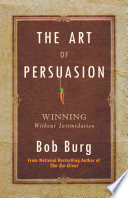

Persuasion is deeply rooted in human psychology. To effectively persuade others, one must understand the underlying psychological principles that drive human behavior. This includes recognizing the importance of emotions, cognitive biases, and social influences. By tapping into these psychological elements, persuaders can craft messages that resonate more deeply with their audience, making it easier to sway opinions and encourage action. Techniques such as establishing credibility, appealing to emotions, and using social proof are all grounded in psychological insights that enhance persuasive efforts.
Continue readingTrust is a cornerstone of persuasion. Without it, even the most compelling arguments can fall flat. The book emphasizes the importance of building trust and establishing credibility with the audience. This involves demonstrating expertise, being honest and transparent, and showing genuine care for the audience's needs and concerns. When individuals perceive the persuader as trustworthy, they are more likely to be influenced by their messages. This section also discusses the role of consistency and reliability in fostering trust over time.
Continue readingStorytelling is an incredibly powerful tool for persuasion. The book highlights how narratives can engage audiences emotionally, making the message more relatable and memorable. By weaving facts and figures into compelling stories, persuaders can create a connection with their audience that mere data cannot achieve. The art of storytelling involves understanding the audience's values and experiences, allowing the persuader to tailor their narrative in a way that resonates with the listeners, thereby enhancing the persuasive impact.
Continue readingCommunication is at the heart of persuasion. The book outlines various communication techniques that enhance persuasive efforts. This includes the use of clear and concise language, active listening, and nonverbal cues. Effective communicators are adept at adapting their style to suit different audiences, ensuring that their message is understood and well-received. The importance of feedback and adjusting one's approach based on audience reactions is also emphasized, as it can significantly improve the effectiveness of the persuasive message.
Continue readingSocial influence plays a crucial role in persuasion. The book discusses how individuals are often swayed by the opinions and behaviors of others, particularly those they admire or consider to be in authority. By understanding the dynamics of social influence, persuaders can strategically position their messages to align with social norms and expectations. This section explores concepts such as conformity, groupthink, and the bandwagon effect, providing insights into how these phenomena can be harnessed to enhance persuasive efforts.
Continue readingResistance is a natural response to persuasion attempts. The book provides strategies for overcoming objections and skepticism from the audience. This includes addressing counterarguments directly, acknowledging concerns, and reframing the message in a way that aligns with the audience's values. By anticipating resistance and preparing thoughtful responses, persuaders can create a more conducive environment for their messages to be accepted. This section also discusses the importance of patience and persistence in the face of resistance.
Continue readingEthics in persuasion is a critical theme throughout the book. The author emphasizes the importance of ethical persuasion, where the intent is to inform and benefit the audience rather than manipulate or deceive. Ethical persuaders prioritize honesty, respect, and the well-being of their audience. This section discusses the fine line between persuasion and manipulation, encouraging readers to reflect on their own persuasive practices and strive for integrity in their efforts. The long-term benefits of ethical persuasion, such as building lasting relationships and fostering trust, are also highlighted.
Continue reading